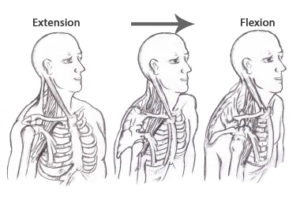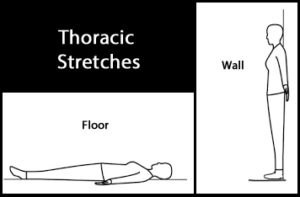Do you have pain or a weird sensation that starts on the side of your neck, pokes deep in the shoulder, runs down your arm, and makes your fingers tingle?
You might have Neurogenic (Thoracic) Outlet Syndrome due to compression of the brachial plexus.
Before we get into why Deep Tissue Massage Therapy might do wonders for this condition, we need to know:
- How we might have got there.
- Some explanation of anatomy for (TOS).
- What can massage therapists do to help.
- What you can do to relieve symptoms.
- And going to your doctor to rule things out.
Let’s start with what people do in life to get symptoms of TOS.
The reason we walk on two feet is because our body prefers to stand upright.
We call standing up perfectly straight, shoulders back, head tall and flat, knees locked out, and hips slightly forward – extension.
Runway models perfect this.
Our body is healthiest when we spend most of our time in extension.
The spine, knees, shoulders and neck love, love, love extension.
Extension means breathing room for joints, organs, muscle and tissue. Extension means space that allows for good blood flow, nerve innervation, and cellular respiration.
Yet, how do we spend our lives, accidents aside?
Instead of extension, our modern way of life promotes something called flexion.

Shoulders Flexed
Example of modern flexion of human behavior:
- Lazy boy chair + TV = forward positioning.
- Video game controller + lazy boy chair = forward shoulder positioning.
- Cell phone texting + any chair = forward shoulder positioning and neck torticollis.
- Driving a car all day = forward shoulder positioning
- Sitting at a computer monitor like I am right now typing this = forward shoulder positioning
And we are not even talking about flexion of the hips, which strains our low backs. That is an entire different article I will be expounding about on a later date.
The reality is that most of us spend countless hours in flexion each day, and unfortunately that has a profound effect on our neck and shoulders.
So how does remaining in flexion cause Thoracic Outlet Syndrome?
Time for some anatomy fun!
Where your shoulder and neck meet there is a small space called the Thoracic Outlet. The clavicle (shoulder bone), the first rib, the subclavius muscle (muscle along clavicle), costoclavicular ligament, and anterior / middle scalene muscles all make up the space for the brachial plexus (nerves from neck) and the subclavian arteries.
Whew – that’s a tongue twister.
Neurogenic (Thoracic) Outlet Syndrome is the compression of this area. Muscles in flexion pull down tight (like a tourniquet) strangling nerves and blood vessels.
Even though accidents or birth defects can also have an effect on this space we, as massage therapists, focus on the muscular issues that cut off blood flow or nerve innervation.
I focus on the anterior and middle scalenes as well as the pectoralis minor (gold spot) from the front, and then slide to the back to bring relief to the rhomboids which are over-stretched.
One thing to keep in mind is that it took a long time to have these muscles get tight and compress vital areas. So in order to undo this damage is, quite frankly, painful!
It’s hard on the hands of a massage therapist if done properly because you have to dig deep to relieve these poor muscles. And it is hard on the client enduring these muscles being stretched.
It also takes four or five treatments over weeks to reverse the symptoms.
However, the alternative is to continue to degrade and suffer. Who wants that. So, as Grandpa said – “No pain no gain” never rang more true than it does with deep tissue therapy.
(Doug Holland, LMT demonstrates how to address (TOS) with sports massage.)
What can you do at home to bring relief to Thoracic Outlet Syndrome?
Experts advise you to take time and stretch your body (extension) every hour.
What I do is hang from a bar. Some use inversion tables and some hang upside down from a pull up bar (not me, thank you).
For most though, lying on the floor (on your back) while trying to pin your shoulders to the floor will suffice.
You will be very surprised how hard it is to get your shoulders to stretch back to the floor while keeping your head back as well.

Floor Exercise
It’s even harder standing against a wall. Remember, your head, shoulders, butt, and heels must all be touching the wall at the same time.
If you have to force yourself back, feel any neck pain, or pain between the shoulders, your body is tight and you are prime for massage therapy treatment.
Once your body is loose you can keep it that way by stretching regularly.
When should you go to a doctor for TOS?
Always get a diagnosis from a doctor before going to a massage therapist. How do we know for sure what it is without the experts looking at the possible condition first?
Conditions that can imitate TOS are:
- Blood clot
- Vascular TOS
- Heart issues
- Rotator cuff damage
- Biceps tendonitis
- Radiculoapathy (pinched nerve in neck)
Okay, so we get the point, make the LMT happy with a doctor’s diagnosis.
If you would like me to work on you click here for rates, office hours, and directions.
Doug Holland, LMT
Tim Neuberger
“Doug is amazing. He knows what your body needs and finds things going on that you didn’t even know were there. I will definitely be going to him again.”
